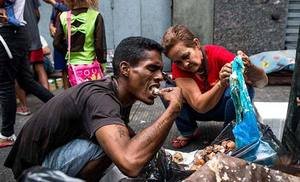How Venezuela fell into ruin?
The Venezuelan crisis is one of the "biggest" in the world in 50 years, and it does not hit bottom

Between 2004 and 2015, the country with the largest reserves of crude received some 750,000 million dollars from the longest bonanza in a century of oil exploitation.
The government of Hugo Chávez (1999-2013) took advantage of the boom to finance itself at low cost. It issued some 62,000 million dollars in sovereign bonds and oil PDVSA, according to the consultancy Ecoanalítica, and received loans from China and Russia. The external debt increased fivefold to 150,000 million dollars.
International reserves reached 42,300 million in 2008. Today they are a quarter. Public spending also shot up, and in 2012 there was a deficit of 15.6% of GDP despite the fact that a barrel of oil reached a record average of 103.42 dollars.
At the time, the socialist government nationalized sectors such as cement and steel and expropriated hundreds of companies.
Since 2003, it monopolizes the currencies it sells at rates that overvalue the bolívar and imposed a price control that, with subsidized expropriations and imports, undermined the industry.
"The private sector was induced to replace production with cheap imports," Ochoa said. The business sector today supplies 20% of the consumption compared to 70% in 2008, according to Fedeagro.
The exchange control resulted in corruption, with ghost imports, overbilling and diversion of dollars to the black market, where the quotations multiplied by 12 the official.
Presumed abuses are added with reserved expenses. According to Jorge Giordani, Chávez's economic guru, 300,000 million dollars were embezzled in the last decade.
The nationalizations diminished several companies and ended in litigations like the one of the oil company ConocoPhillips, that took assets of Venezuela in the Caribbean to receive 2,000 million dollars.
The government defends that between 1999 and 2014 it allocated 718,000 million dollars to social programs.
But fiscal management is disorganized, with the issuance of money to cover a hole from 15% to 20% of GDP on average since 2013, according to Humberto García, president of the National Academy of Economic Sciences.
The road to collapse was traced when oil collapsed from $ 98.98 per barrel, in July 2014, to 47.05 at the end of that year and to an average of 35.16 in 2016.
Revenues, of 121,000 million dollars in 2014, fell to 48,000 million in 2016. The bomb exploded Maduro.
PDVSA's production plummeted from 3.2 million barrels per day in 2008 to 1.5 million barrels in April, according to OPEC. Thus, the price rebound has a limited impact.
As an adjustment, the government reduced imports and the delivery of foreign currency, sharpening the shortage of food and medicines.
Imports, of 66,000 million dollars in 2012, will be of 9,200 million in 2018, estimates Ecoanalítica.
The financing of the deficit and the "black dollar" triggered by the currency drought generated a hyperinflation that according to the IMF will reach 13,864.6% this year.
This spiral destroyed wages the minimum income gives for half a kilo of meat and caused a shortage of bills by lagging the monetary cone. A new one, with three less zeros, will circulate from June.
The GDP contracted 45% since 2013, according to the International Monetary Fund, going from 400,000 million dollars to 120,000 million. "Indicators of a country at war", according to Asdrúbal Oliveros, of Ecoanalítica.
Due to delayed debt payments, Venezuela and PDVSA were declared in partial default in 2017, with commitments for the next four-year period of 10 billion dollars per year.
Maduro, who calls himself a victim of "an economic war," announced a renegotiation, but since August Washington has barred Americans from negotiating new Venezuelan debt.
An embargo would be imminent, cautions Alejandro Grisanti, of Ecoanalítica, who predicts that crude production would fall to 1.2 million barrels per day by the end of 2018.
The United States is witnessing an oil embargo, a catastrophic scenario since one third of the production goes there and represents 75% of the cash flow.
The Venezuelan crisis is "the largest" in the world in 50 years, warns the IMF. And it does not hit bottom.
I really wonder how cryptocurrencies are going to effect these dictatorships. There’s already huge activity in Bitcoin just to survive, but Steem could bring it to the next level. Incentivizing social activity has a lot of potential.